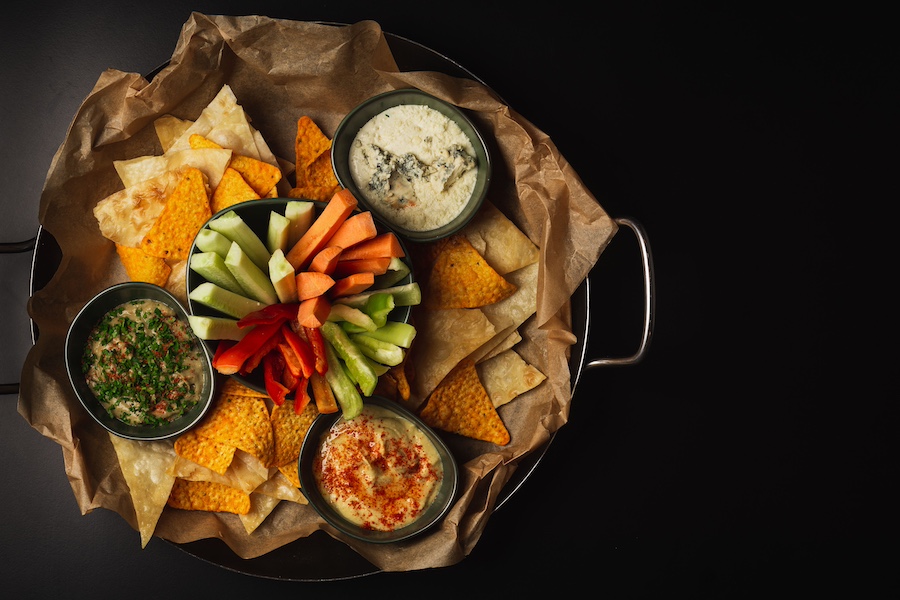Cannabis and food have a harmonious relationship.
THC interacts with the endocannabinoid system, stimulating our sense of smell and taste. It also releases the ghrelin hormone, which stimulates hunger.
Additionally, THC triggers an increased dopamine release, enhancing one’s pleasure while gnashing on good eats [1].
Everybody and their mother is familiar with the munchies—they’re one of the core tenets of a top-tier cannabis experience. Rare is it one can equal the euphoria of a healthy, responsibly yielded buzz from your favorite indica, sativa, or hybrid combined with a tasty treat, be it a chocolate bar, a rich entree, a bag of potato chips, an exotic delicacy, etc.
Yet, everything detailed above isn’t the only reason cannabis and eating go hand in hand.
Cannabis, indeed, does make food taste better—but it can also be incorporated directly into our food in exciting, artistic, and inventive manners.
This article will explore the cooking techniques of infusing cannabis into our food.
Cannabis Cuisine: A Matter Of Taste
Before legal cannabis seemed like it’d ever be possible anywhere in North America, the available edibles didn’t offer much in the way of taste or options. People were willing to take cookies, muffins, and chocolate bars that tasted more like a burnt weed plant than the pastries themselves.
These days, with legalized recreational cannabis for adults over 21 increasingly becoming the norm, the average enthusiast’s tastes have grown more discriminating.
That said, some cannabis users derive pleasure from intense cannabis flavors in their infused eats.
Nonetheless, our aim in the following content will be to develop cannabis-infused dishes that taste good without sacrificing THC content.
It Starts With A Delicious Base
You’ll have the easiest time incorporating cannabis into your dishes if you learn how to make cannabis butter (or a similar base, like oil).
After all, butter is virtually omnipresent in most dishes, including those brimming with cannabis and THC.
The most crucial thing in making cannabutter is the decarboxylation process, which activates the THC when it’s incorporated into food [2].
While “decarbing” is a frequent cause of taste-related issues, there are measures you can take to offset the bitterness and acridity.
Some food experts suggest complementing cannabis’s strong essence with spices and food-grade essential oils. Warming spices (e.g., cinnamon and ginger) can balance the potent cannabis notes, bolstering pastries and savory dishes calling for those ingredients.
You can also sacrifice some potency for flavor, subbing the cannabis butter with real butter.
We suggest speaking with your local cannabis baker (preferably one whose dishes you enjoy) and inquiring about what they do to not sacrifice flavor for potency or vice versa [3].
Here’s a step-by-step guide from Food & Wine Magazine on how to make cannabis butter. Also, here’s a guide for making cannabis oil since it’s the other most common base ingredient for cannabis-infused dishes.
A Quick Explanation Of Cannabis Decarboxylation
Regardless of whether you’re making cannabis butter, cannabis oil, jam, etc., decarboxylation is the only way to maximize your concoction’s active THC [4].
Here’s all you’ll need to get the job done:
- Baking tray.
- Parchment paper.
- Cannabis flower with the seeds and stems picked out.
Next, all you need to do is:
- Set the oven temperature to 225°F and let it preheat.
- Without using your grinder, break up your dried flower into smaller pieces.
- Place the parchment paper over the baking tray before placing a single layer of cannabis on top, leaving tiny spaces between every piece.
- Place the tray into a preheated oven and let it heat for 45 minutes. Ensure it’s on the middle rack.
- After 45 minutes is up, remove the tray of decarbed cannabis and let it cool.
- Then, seal your decarbed cannabis into a container until you’re ready to use it.
Realistically, at this point, the world is your oyster when it comes to cooking with cannabis—you have the key ingredient: decarbed cannabis.
Other Tricks Of The Trade When Cooking With Cannabis
The mistake most people make when cooking with cannabis is setting the temperature too high. Going above 365°F will degrade the THC in your dish, diminishing the effects you’re seeking and defeating the entire purpose.
To be safe, don’t go over 340°F since ovens and stovetops are frequently inaccurate with temperatures.
Also, be mindful of when you add your cannabis oil or butter.
For instance, adding cannabis butter too early at a high temperature to saute garlic in onions might seem tempting, but it’ll rob you of precious THC.
The best time to add your THC-infused butter or oil to your dish is when the food is almost ready after you remove the pan from the heat. While you mix in the cannabis oil or butter, it will cook into your dish—but only as much as needed.
Mix Cannabis-Infused Concoctions Thoroughly For Precise Dosages
Edibles and smoking are vastly different experiences—with the former yielding more intense highs—calling for a need to practice caution when infusing dishes with cannabis oil or butter.
Part of that caution is mixing THC-infused dishes thoroughly.
Unevenly mixed THC in your cannabis dishes means some portions will be bereft of the desired effects while others will come on too hard and strong.
Moreover, we suggest using containers with flat bases to offset the risk of high-density ingredients (such as those found in fudge, chocolate, etc.) pooling at lower areas and impeding even distribution.
Storage Tips: Where To Keep Your Cannabis Infused Snacks
A lot of cannabis-infused cooking involves pastries or snacks you can store for later consumption. Here are some tips on how to safely store your cannabis-infused concoctions:
- Like any other regular food, savory items should be kept in the fridge, and pastries (e.g., cookies) should be kept in the pantry.
- Edibles with a strong cannabis scent (e.g., butter and oils) are best stored in sealed containers that lock in the smell.
- Clearly label your cannabis-infused treats and eats to ensure it doesn’t accidentally get eaten.
- Ensure all containers containing cannabis edibles are kept far away from the reach of children.
And if you’re seeking top-notch cannabis for your cannabis butter or oil, look no further than our menu of premium flower, pre-rolls, concentrates, and more at One Green Leaf.
Sources
- https://www.cnn.com/2024/04/20/health/munchies-weed-hungry-high-wellness/index.html#:~:text=THC%20also%20increases%20the%20release,can%20lower%20inhibitions%2C%20Hultin%20explained.
- https://www.foodandwine.com/recipes/premium-cannabutter
- https://merryjane.com/culture/mother-knows-best-making-budder-taste-better/
- https://www.nuggmd.com/blog/cooking-with-cannabis-a-beginners-guide-to-making-marijuana-edibles



